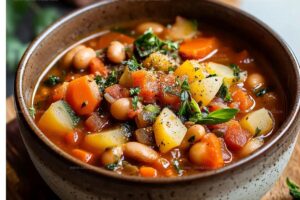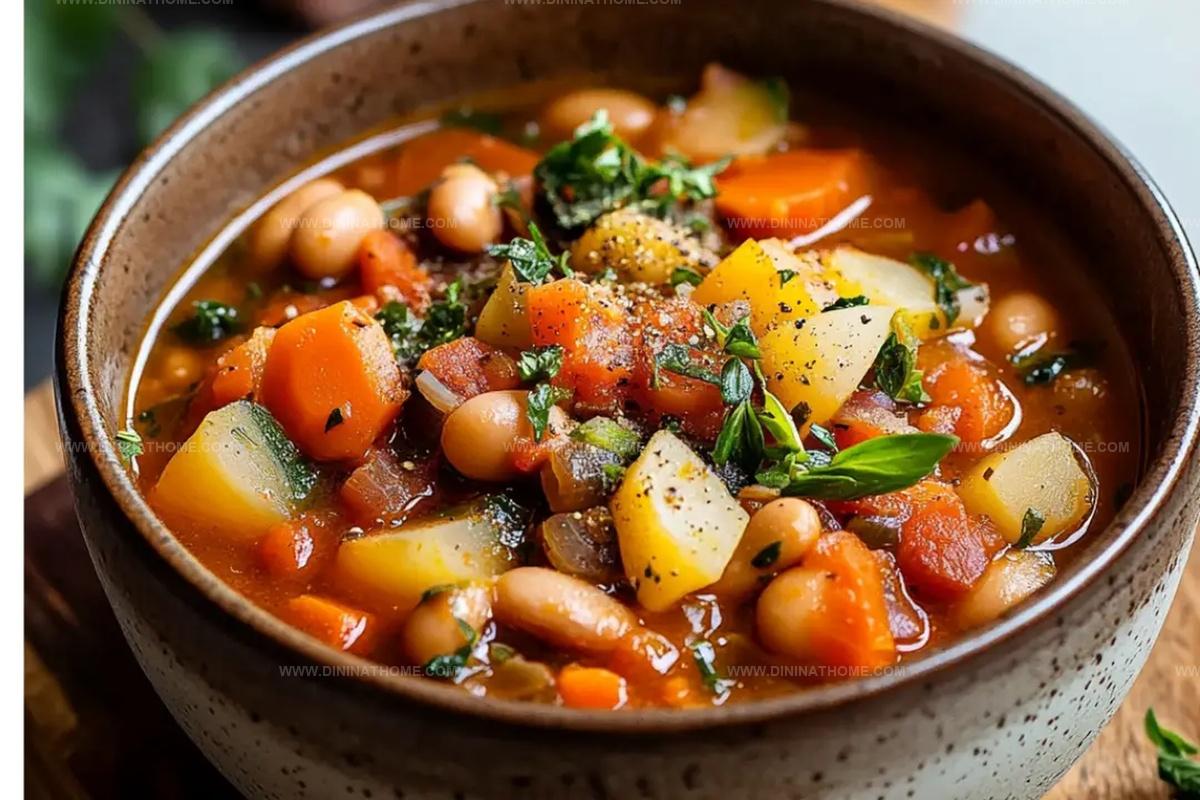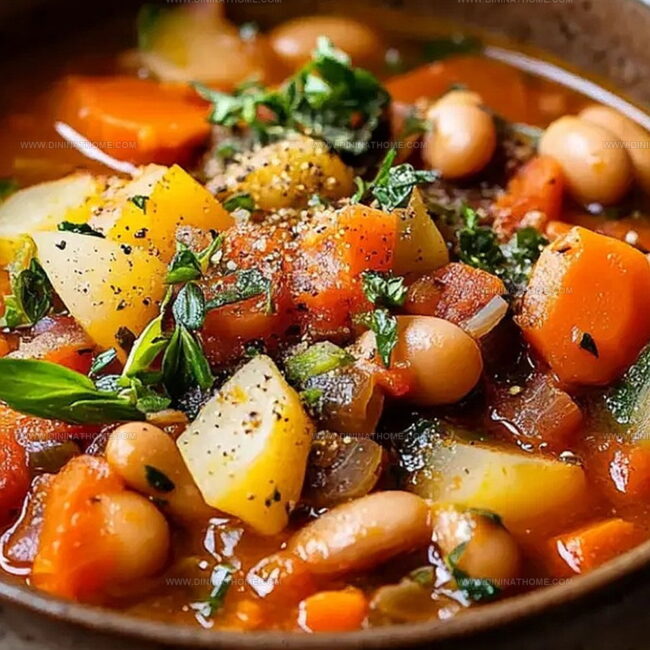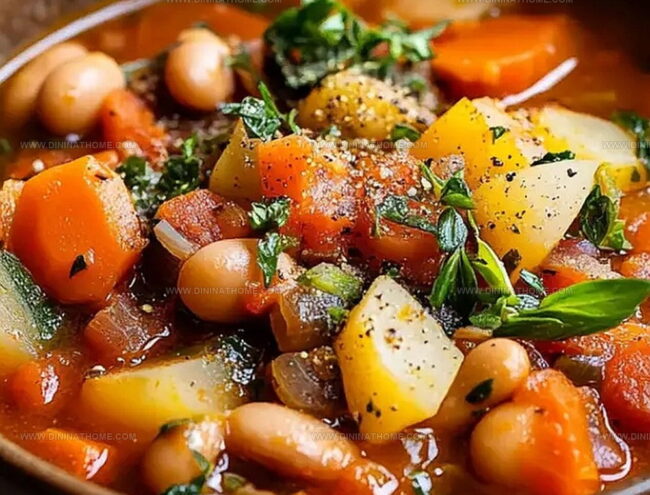Cozy Butterbean Vegetable Stew Recipe for Homestyle Comfort
My grandma’s secret butterbean vegetable stew recipe always brings comfort during chilly evenings.
Hearty ingredients dance together in a rustic pot, creating magic with every stir.
Nutritious and warming, this classic dish connects generations through simple, wholesome flavors.
Southern kitchens know how to turn humble ingredients into spectacular meals that nourish both body and soul.
Fragrant herbs and tender vegetables mingle with creamy butterbeans, promising a delightful culinary experience.
Each spoonful tells a story of traditional cooking and love.
Dive in and savor the rich, soul-satisfying warmth waiting just for you.
Why Butterbean Vegetable Stew Will Win You Over
Butterbean Vegetable Stew Ingredient Snapshot
Main Vegetables:Beans and Grains:Liquid and Flavor Components:Herbs and Seasonings:Fresh Finishing Ingredients:Cooking Fat:Vegetable Stew with Butterbeans Simplified
Step 1: Sauté Aromatic Onions
Heat olive oil in a large, heavy-based pot over medium-high heat.
Add diced onions and cook while stirring occasionally until they become soft and translucent, releasing their sweet fragrance.
Step 2: Layer Root Vegetables
Introduce carrots and potatoes into the pot, allowing them to sizzle and develop rich, deep flavors.
Stir and cook for several minutes until the vegetables start to soften slightly.
Step 3: Build Flavor Foundation
Add the following ingredients:Thoroughly mix all ingredients to create a harmonious blend of textures and tastes.
Step 4: Simmer and Develop Depth
Raise the heat to high and bring the mixture to a vigorous boil.
Immediately reduce heat to low, allowing the stew to gently simmer uncovered.
Stir every 5 minutes to prevent sticking and ensure even cooking.
Cook until potatoes and rice reach perfect tenderness.
Step 5: Incorporate Leafy Greens
Remove and discard woody thyme stems.
Fold in chopped silverbeet, kale, or spinach, letting the greens wilt and integrate into the stew.
Remove pot from heat once greens are tender.
Step 6: Serve with Brightness
Ladle the steaming stew into warm bowls.
Enhance with a fresh squeeze of lemon juice and sprinkle of chopped parsley.
Accompany with crusty sourdough bread for a complete, comforting meal.
Butterbean Stew Tips for Maximum Comfort
Save Butterbean Vegetable Stew Leftovers
Satisfying Matches for Butterbean Stew
Butterbean Stew Serving Suggestions
FAQs
Arborio rice releases starch while cooking, creating a naturally creamy and thick texture that helps bind the stew ingredients together without needing additional thickeners.
Yes, you can use cannellini, great northern, or navy beans as direct replacements for butter beans while maintaining a similar creamy texture and nutritional profile.
Cut vegetables into similar-sized pieces and follow the cooking times precisely. Stir occasionally and maintain a low simmer to prevent overcooking and preserve vegetable texture.
Absolutely. The combination of beans, vegetables, rice, and herbs provides a complete protein source, complex carbohydrates, fiber, vitamins, and minerals, making it a highly nutritious one-pot meal.
Print
Butterbean Vegetable Stew Recipe
- Total Time: 50 minutes
- Yield: 6 1x
Description
Hearty butterbean vegetable stew brings Mediterranean comfort to your kitchen, blending rustic ingredients with soul-warming flavors. Fragrant herbs and tender vegetables mingle with creamy butterbeans, creating a nourishing meal you’ll crave on cool evenings.
Ingredients
Vegetables and Beans:
- 2 red potatoes, cubed
- 2 zucchini, diced
- 2 carrots, diced
- 2 cans butter beans, drained and rinsed
- 250 grams (8.8 ounces) silverbeet (Swiss chard), kale, or frozen spinach, chopped
Aromatics and Seasonings:
- 1 brown onion, diced
- 4 garlic cloves, minced
- 5 sprigs fresh thyme
- 1 tablespoon sweet paprika
- 1/2 teaspoon salt
Liquid and Grains:
- 2 cans (14.5 ounces each) diced tomatoes
- 4 cups vegetable stock or water
- 1/3 cup arborio rice
- 1 tablespoon olive oil
Serving Suggestions:
- Sourdough bread
- Fresh parsley
- Lemon juice
Instructions
- Prepare a robust culinary canvas by heating olive oil in a substantial, weighty pot over moderate heat, gently sautéing diced onions until they become translucent and fragrant.
- Introduce robust root vegetables like carrots and potatoes, allowing them to caramelize and develop deep, rich flavors through gentle stirring.
- Enrich the developing stew by layering in zucchini, minced garlic, butter beans, crushed tomatoes, aromatic sweet paprika, delicate thyme sprigs, and seasoning to create a complex flavor profile.
- Incorporate arborio rice and vegetable stock, stirring thoroughly to integrate all ingredients, then elevate the temperature to trigger a vigorous boil before reducing to a gentle simmer.
- Monitor the stew’s progression, occasionally stirring to prevent adherence to the pot’s bottom, ensuring rice and root vegetables achieve perfect tenderness within 20-25 minutes.
- Eliminate woody thyme stems and gracefully fold verdant silverbeet or alternative leafy greens into the stew, allowing them to wilt and infuse additional nutritional depth.
- Finalize the dish by transferring the aromatic stew into serving vessels, enhancing with a bright citrus burst from fresh lemon juice and garnishing with verdant parsley.
- Present alongside crusty sourdough bread to complement the stew’s rich, comforting essence.
Notes
- Swap arborio rice with quinoa or cauliflower rice for a lower-carb, gluten-free alternative that maintains the stew’s creamy texture.
- Boost protein content by adding cooked chicken, tofu, or tempeh for a heartier meal that satisfies different dietary needs.
- Use fresh thyme leaves instead of sprigs for a more intense herb flavor and easier eating experience without removing woody stems.
- Customize heat levels by adding red pepper flakes or a dash of hot sauce for those who enjoy spicier vegetable stews.
- Prep Time: 15 minutes
- Cook Time: 35 minutes
- Category: Dinner, Lunch
- Method: Sautéing
- Cuisine: Mediterranean
Nutrition
- Serving Size: 6
- Calories: 180
- Sugar: 4g
- Sodium: 500mg
- Fat: 6g
- Saturated Fat: 1g
- Unsaturated Fat: 5g
- Trans Fat: 0g
- Carbohydrates: 30g
- Fiber: 8g
- Protein: 8g
- Cholesterol: 0mg




James Walker
Lead Recipe Developer & Culinary Educator
Expertise
Southern Cuisine & Farm-to-Table Cooking, Recipe Development & Testing, Culinary Education & Instruction
Education
School: Auguste Escoffier School of Culinary Arts
Program: Diploma in Culinary Arts and Operations
Focus: Comprehensive training in classical and modern culinary techniques, kitchen operations, and farm-to-table practices.
James didn’t learn cooking from a TV show, he learned it from busy kitchens, family gatherings, and long afternoons spent testing recipes the hard way.
After training at the Auguste Escoffier School of Culinary Arts, he brought his love for real, down-to-earth food to every dish he makes.
At Dining At Home, James loves building recipes that feel familiar but still have something special, like adding a twist to a classic or making a slow Sunday dinner feel brand new.
When he’s not in the kitchen, you’ll probably find him swapping garden tips at the farmers’ market or teaching his daughter how to flip pancakes without a mess (almost).